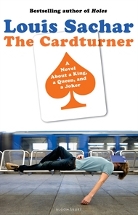The cardturner by Louis Sachar

Bloomsbury, 2010. ISBN 9781408808504.
(Age: Secondary) Highly recommended. When told by his avaricious mother
to be the card turner for his
elderly blind Uncle Lester, Alton is made aware that the fate of his
family rests upon his 17 year old shoulders. His father's retrenchment
adds even more cachet to his mother's aggressive mantra 'tell him he's
your favourite uncle', but going along one Saturday turns into an
almost daily trip. He is to tell his uncle what cards he has in his
hand for the 26 boards of bridge, and then table the ones he is told to
play. Alton is not impressed with his job, but comes to know more about
the man and his relations as the strange girl, Toni, takes her place as
the man's partner. Alton has been brought up to believe that this side
of his family, particularly Toni, is crazy, and that they are also
interested in Lester's will. Alton's mother has fed him all sorts of
stories about Toni and her mother, and these stories colour his view of
the family, particularly Annabel, who he believes could be Toni's
grandmother, as she was Lester's bridge partner many years before.
But when Lester dies before the National Championships, Toni and Alton
decide to enter in Lester's and Annabel's names, to play out the
championship which led to her incarceration in an asylum, resulting to
her eventual suicide.
As Lester and Annabel, they play the event, and as Toni and Alton,
their relationship becomes a lot closer.
Alton is immensely likeable, torn between his mother and the needs of
his family, and those of his Uncle Lester, to whom he is increasingly
drawn. Alton's foibles are quickly documented, his cooling relationship
with his best friend, Cliff and his new girlfriend, Katie, once Alton's
girlfriend, his relationship with his family and particularly his
sister, Leslie, all are created with absolute ease. The story flows
like nothing else I have recently read, and to think that much of it
revolves around a game of cards makes it even more impressive. Sachar
infiltrates the rules and niceties of the game of bridge with a deft
touch, making it understandable to all readers. And for those not
interested in learning the rules of this game, then he allows readers
to skim over those sections, using a ploy which further maintains the
readers' interest and enjoyment. A very funny story for secondary
readers.
Fran Knight